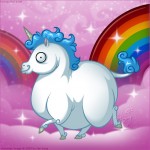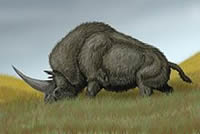by Fr. John Whiteford
Stump the Priest: Unicorns?

Question:
“In the antiphons of the feast of the Transfiguration I was struck by a reference to unicorns. What does that mean?”
In the second antiphon of the feast, there are three stichoi:
Stichos 1: The mountains of Zion on the side of the north, the city of the Great King (Psalm 47:3 LXX, 48:2 KJV)
Stichos 2: And He brought them unto the mountain of His sanctuary, this mountain which His right hand had gained as a possession (Psalm 77[78]:54).
Stichos 3: Mount Zion which He loved, and He built His sanctuary like that of a unicorn (Psalm 77[78]:68-69).
Each stichos is followed by the refrain:
“O Son of God Who wast transfigured upon the mountain, save us who sing to Thee: Alleluia.”
The Psalm verses, which reference the mountain of God’s sanctuary are obviously being tied to the Transfiguration on Mount Tabor. But before we get into the meaning of this particular passage, let’s consider the wider meaning of “unicorn” in the Scriptures.
The Hebrew words for this creature are riem, rieym, reym, or rem, and its root is related to the word “rise” râ’am.
Unlike the gentle unicorns we tend to think of when we hear that word, unicorns in Scripture are used as symbols of strength. For example, in Numbers 23:22, it states:
“God brought them out of Egypt; he hath as it were the strength of an unicorn.”
In Psalm Psalm 21[22]:22, it refers to unicorns in a parallelism with lions:
“Save me from the mouth of the lion, and my lowliness from the horns of the unicorns.”
In the Greek Septuagint, this words is consistently translated as “monokerotos“, which literally means “single-horn”, which is also what the word “unicorn” means. What is interesting is that in St. Jerome’s translation of the Vulgate, he often uses the Latin word “unicornis“, which is where we get the English word, but at other times he uses the Latin word “rinoceros” (rhinoceros), and this is reflected in the Douay-Rheims translation of Numbers 23:22:
“God hath brought him out of Egypt, whose strength is like to the rhinoceros.”
There are several species of Rhinos still in existence. Some of them have two horns, though one is large and the other one is smaller, and both are on the nose. Others have one horn only. In fact, the scientific name for a single horn Rhino is “Rhinoceros unicornis“.

It is also interesting to note that in some passages in Hebrew, a singular “unicorn” (re’em) is spoken of as having plural horns
“His glory is like the firstling of his bullock, and his horns are like the horns of a unicorn…” (Deuteronomy 33:17),
which St. Jerome’s texts has as “his horns as the horns of a rhinoceros”). However, in other places, it is clear that it refers to an animal with only one horn (“But my horn shall be exalted like that of the unicorn” (Psalm 91:11 LXX, (92:10 KJV).
If various types of Rhinos are in view, single-horned and double-horned varieties exist. These animals also cannot be domesticated, which is consistent with the description found in Job 39:9-10:
“Will the unicorn be willing to serve thee, or abide by thy crib? Canst thou bind the unicorn with his band in the furrow? or will he harrow the valleys after thee?”
Also, in the instance in Deuteronomy 33:17, when plural horns are spoken of, the horns are compared to the half-tribes of Ephraim and Manasseh:
“His glory is like the firstling of his bullock, and his horns are like the horns of a rhinoceros: with them he shall push the people together to the ends of the earth: and they are the ten thousands of Ephraim, and they are the thousands of Manasseh.”
The tribe of Ephraim was much larger than the tribe of Manasseh, which fits the analogy of the horns of a two-horned Rhino.
There were also some now extinct relatives of the Rhino, the Elasmotherium, that was much larger than a rhino, and had a huge single-horns — and based on cave drawings, there is good reason to believe that ancient humans had some interaction with some of them.

So these references are not to a fairy-tale animal that flies through the air, and leaves a trail of pixie dust in its wake — it refers to an animal that people recognized as very strong, fierce, and a creature who could not be tamed by men.
Now, getting back to the psalm verses used in the second Antiphon. The full psalm verses quoted in part in stichos three read:
“And He chose the tribe of Judah, Mount Zion which He loved. And He built His sanctuary like that of a unicorn, on the earth He established it for ever” (Psalm 77[78]:68-69).
Here is what the Fathers say about these verses:
Blessed Theodoret: “”He built His sanctuary like a unicorn” (v. 69). They say the unicorn is equipped with one horn, and the Law gave instruction for the adoring of one God; and so it was right for him to liken the one Temple, dedicated to the one God, to a unicorn”(Theodoret of Cyrus: Commentary on the Psalms, 73-150), trans. Robet C. Hill (Washington, D.C.: Catholic University of America Press, 2001), p. 39).
St. Augustine: “Lastly there followeth, “and He builded like as of unicorns His sanctification” (ver. 70): or, as some interpreters have made thereof a new word, “His sanctifying.” The unicorns are rightly understood to be those, whose firm hope is uplifted unto that one thing, concerning which another Psalm saith, “One thing I have sought of the Lord, this I will require”” (NPNF1, p. 379).
Cassiodorus: “”Unicorns”” signifies those who posses a single hope in the most holy Trinity, towards which the consecrated hearts of the faithful are humbly raised, and they rely on the constancy of faith as the strongest of horns” (Cassiodorus: Explanation of the Psalms, Vol. 2, trans. P. G. Walsh, (New York: Paulist Press,1991), p. 273).
